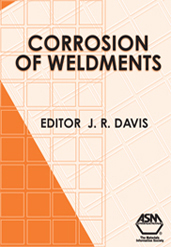Corrosion of Weldments B-ASM-007

Chapters on specific alloys groups—carbon and alloy steels, stainless steels, high-nickel alloys, and nonferrous alloys—describe both general welding characteristics and the metallurgical factors that influence corrosion behavior. Corrosion problems associated with dissimilar metal weldments are also examined. Special challenges caused by high-temperature environments are discussed. Commonly used methods to monitor weld corrosion and test methods for evaluation of intergranular, pitting, crevice, stress-corrosion cracking, and other forms of corrosion are also reviewed.
SAE MOBILUS
Subscribers can view annotate, and download all of SAE's content. Learn More »

Corrosion: Understanding the Basics

Surface Engineering for Corrosion and Wear Resistance
